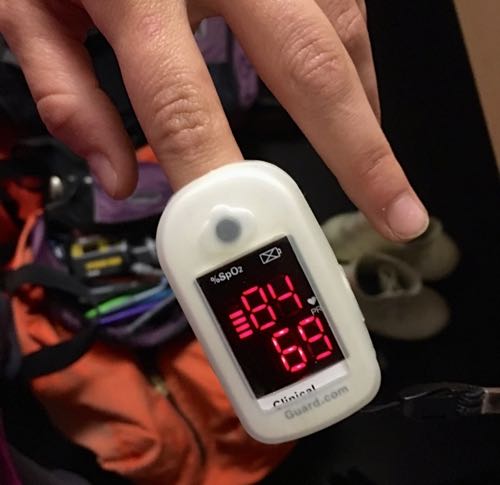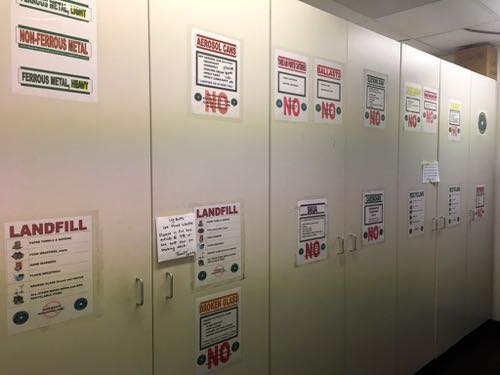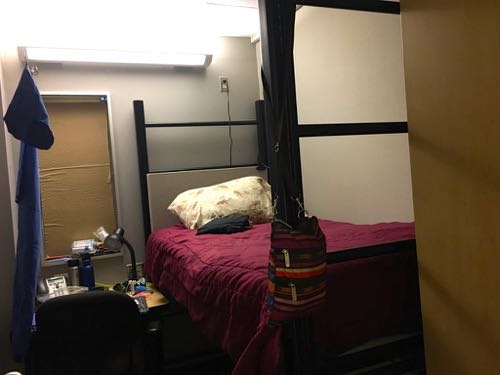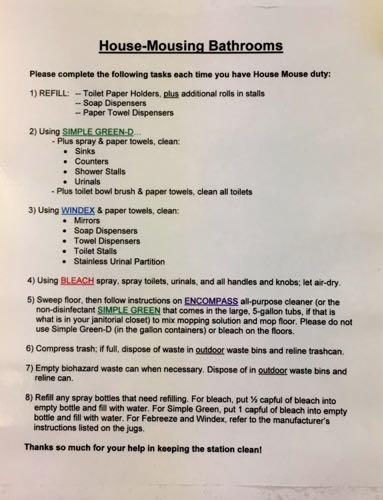Altitude Sickness
Unlike McMurdo at sea level, the South Pole Station sits at a pretty high altitude. Around 9,200 feet, in fact. Because of this, altitude sickness becomes a big concern.
Altitude sickness happens when you cannot get enough oxygen from the air at high altitudes. Typical symptoms include headaches, loss of appetite, nausea, and trouble sleeping.
I brought along a pulse oximeter – an instrument that reads the amount of oxygen in your blood. When I was in New Zealand I took a baseline reading. The percent oxygen in my blood fluctuated between a healthy 98% and 99%.
Then I took a reading the first night that I arrived at the South Pole. The percent oxygen in my blood had fallen to 84%!
 A pulse oximeter reading the percent oxygen in my blood (top number) and my heart rate (bottom number). I took this photo the day I arrived at the South Pole. The oxygen in my blood is 84%, down from 98%/99% baseline reading in New Zealand. You can really see the effects of the thinner air at this altitude.
A pulse oximeter reading the percent oxygen in my blood (top number) and my heart rate (bottom number). I took this photo the day I arrived at the South Pole. The oxygen in my blood is 84%, down from 98%/99% baseline reading in New Zealand. You can really see the effects of the thinner air at this altitude.
We’re told to take it easy for the first few days. Drink lots of water, take many naps, and don’t push it. So far I’ve only had a slight headache. I think the anti-altitude sickness medicine I got from the nurse in Christchurch is helping a lot!
Sun Protection
At the South Pole, the sun is really intense. For one thing the sunlight is reflected right back at you off the white ground. In addition, without water vapor above to absorb the UV rays, combined with the Ozone hole, sun protection is a must here!
Before I go outside, not only do I dress in all of my Extreme Cold Weather (ECW) gear, but I also put sunscreen on any exposed skin. Of course, with the cold I don’t have much skin exposed to begin with, but my cheeks and nose sometimes peak out.
I’m also careful to always wear polarized goggles or sunglasses to protect my eyes from the sunlight. I want to prevent “sun blindness” which is kind of like getting sunburn on your eyes. I’ve never had it, but I hear it’s very uncomfortable. Ouch!
Conserve & Recycle
Lastly, we’re very conscious at the South Pole (and really everywhere in Antarctica) to conserve energy and reduce waste.
Almost all of the energy used at the South Pole Station ultimately comes from jet fuel (basically a special diesel rated for cold conditions). This includes melting ice into water, stoves for cooking, and electricity that comes out of the wall. And that jet fuel needs to be flown in on (you guessed it) a jet! This can all get very expensive.
In fact, when planes come to the South Pole, we actually suck as much fuel out of the plane to add to the fuel reserves here, obviously leaving enough for the plane to get back to McMurdo safely.
So we do our best to turn off lights in empty rooms and unplug unused devices. We also conserve water here, except when it comes to washing our hands so we don’t spread germs and staying hydrated. This includes showers – here we’re allotted TWO shows per week. Laundry is also limited to ONE full load per week. It might get a little smelly here.
Additionally, in accordance with the Antarctic Treaty, all waste (except human waste) needs to be taken off of Antarctica. That means all food scraps, recyclable, and landfill waste is flown out of the South Pole. Again, this can get expensive.
 The recycling room at the South Pole Station. With so many categories, we have to be careful to sort our waste into the right bin.
The recycling room at the South Pole Station. With so many categories, we have to be careful to sort our waste into the right bin.
So we’re very careful here to use only what we need. I take only the food I know I will eat and I use one paper towel instead of two.
Circadian Clock
My circadian clock, that little internal voice that tells you it’s time to go to bed and time to wake up, is way off. With 24-hours of sunlight, I never know when to eat, sleep, work, or relax. It’s truly a very weird feeling.
I find myself carrying around my cell phone almost anywhere just so I have a clock to look at.
The cardboard over my dorm room window does help to block out the light, which is especially important when I’m trying to fall asleep.
 My dorm room at South Pole Station. Notice the cardboard over the window - it works really well at keeping the sunlight to a minimum in the room.
My dorm room at South Pole Station. Notice the cardboard over the window - it works really well at keeping the sunlight to a minimum in the room.
But even so, it’s pretty weird to get up in the middle of night and have it look like afternoon outside.
House Mouse Duties
At South Pole Station there are stewards to clean the main hallway and most common spaces. But the dorm rooms and bathrooms are our responsibilities.
Each person is assigned a day of the week to take “House Mouse” duties.
 Posted inside my dormroom door is my assigned day for "House Mouse" duties (i.e. cleaning the bathroom.
Posted inside my dormroom door is my assigned day for "House Mouse" duties (i.e. cleaning the bathroom.
 The list of responsibilites of the House Mouse posted inside each bathroom.
The list of responsibilites of the House Mouse posted inside each bathroom.
Although cleaning the bathroom is not my favorite task, it really helps out to split up the responsibilities. As a result, the South Pole Station is extremely clean!
Questions?
Have a question about what life is like at the South Pole? Post it in the comments below and I’ll get back to you!


Comments
Add new comment